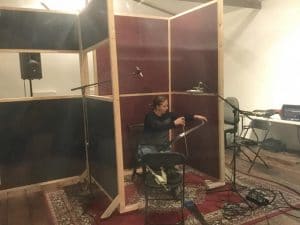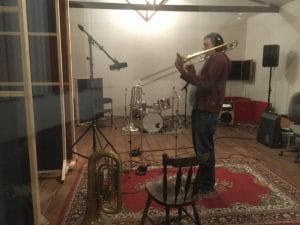
Strata String Quartet with Peter Byrom-Smith and LB
The string quartet shuffle the pages of their manuscripts and allow the sheets we’ve already covered to fall to the floor like dead leaves.
“Right” I say, “here’s a bit of context for the next one: Jocasta is at her lowest ebb yet perversely buoyed up by the hopelessness of it all, bristling with a fatal energy brought on by inescapable truths…”
The musicians wear poker faces, continuing to humour me.
“She stands atop the battlements and sings a song of defiant resignation, she is alone with the elements, it is a dark but clear night…”
They know that a deeply unhelpful piece of guidance is coming.
“Think of the string section as being the wind blowing through her hair.”
There it is. Dan the engineer closes his eyes and massages his temples in silence, the very image of stoicism.
“Got it” says Rod, the cellist.

Fran Lydiatt on accordion
The greatest pleasure of a recording project like this is that we are not simply laying down a collection of songs but attempting to create an entire world. Many tracks in popular music exist as a window into the writer’s mind or a response to some shared aspect of the human condition – our relationships with them can be very personal, even intimate. But in a musical we glimpse not only the moments in a person’s life but entire narratives: the singers are bound by circumstances, the emotions are not abstract, they are reactive; a love song is not general but specific. They are surrounded – hemmed in even – by place and time.
In my article about the singers I talked about how if the character is not convincing to the audience then it does not matter how good the orchestrations are, the moment is lost. But really the relationship is more symbiotic than that. Regardless of how iconic Humphrey Bogart and Claude Rains are in the final scene of Casablanca if they delivered those lines in front of a vacant green screen rather than a foggy airstrip in Morocco our imaginations would simply fail to be transported.

Kirsty McGee on saw
So in our aural palette we use a lot of brass and strings to reinforce the drama and the emotional toll exerted upon the protagonists. But that’s only part of it. There are also lighter, more personal moments that require a corresponding playfulness or sensitivity. Sometimes the orchestrations exist not to show outer context but inner contradictions. All of us see ourselves in a certain way, but frequently those around us have a markedly different idea of who we are. For example, Tom Hingley‘s character is a pompous barfly who sings a song about the glories of alcohol. As he gets into his stride the orchestration becomes more complicated: a brass band denotes the confidence of intoxication, the flute line is how he views himself, all respectable and articulate, yet underneath it all is a quivering musical saw that suggests he is far from steady on his feet. Similarly there is a song Felix Hagan sings that is comprised almost entirely of gorgeous strings swirling about dramatically (scored by the brilliant Peter Byrom-Smith). This is how he sees himself, all majestic and tragically thwarted; but really that character is a whinging egotist given to acts of extreme cruelty and selfishness. The contradictions are everything, partly because it makes for more interesting characters, but mostly because that’s just how we all live our lives to some degree.

Biff Roxby on ALL the brass
I am very lucky to be able to draw on such a great community of musicians who aren’t afraid to step out of their comfort zones or try strange ideas. I’ve already talked about the wonderful rhythm section but a big mention must also go to my former Bedlam Six colleagues Fran Lydiatt (his exceptional piano playing is on nearly every track – and when it isn’t he’s likely to be on the organ, accordion or vocal harmonies) and Biff Roxby (who has scored out and played all the brass parts, giving by turns an uplifting and unsettling texture to the record). There are also some wonderful moments by Kirsty McGee who came into the studio to lay down flute parts but ended up also playing saw – both tenor and bass (I’ve never heard saws played in harmony before!). And of course the aforementioned Peter Byrom-Smith scoring for the sublime Strata String Quartet whose contribution not only lends a certain respectability to the project but also a lot of emotion and grandeur.
Without such a team this narrative would be the bullet points of a synopsis rather than the living prose of a novel.
BACK TO MAIN JOCASTA PAGE
Read an article about adapting the myth
Read an article about composing the songs
Read an article about writing the script
Read an article about the studio team
Read an article about recording the rhythm section
Read an article about recording the singers
Read an article about recording the crowd vocals
Read an article about mixing the album
View photos from the Lowry showcase event
View rehearsal photos
Project Overview / Final Thoughts
And here’s a piece about being funded by Arts Council England

